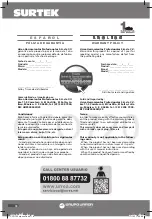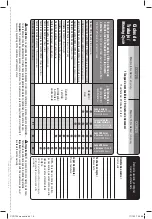
15
E N G L I S H •
User's manual
Cracks in core.
Blade flutters in cut as a result of losing blade
tension. Tighten the blade shaft nut.
Blade specification is too hard for the mate-
rial being cut. Make sure blade is running at
proper speed and that drive pin is functioning
properly. Use a softer bond/matrix to eliminate
stress.
Loss of tension.
Core overheating. Make certain blade RPM is
correct.
Core overheating as a result of blade spinning
on arbor. Check water flow, distribution and
lines. Tighten the blade shaft nut.
Core overheating from rubbing the material
being cut. Make certain the drive pin is func-
tioning. Properly align the saw to square cut.
Unequal pressure at blade clamping collars/
flanges. Collars/flanges must be identical in di-
ameter and the recommended size.
Blade is too hard for the material being cut.
Use a softer bond/matrix to reduce stress.
Blade wobbles.
Blade is on a damaged or worn saw. Check for
had bearings, bent shaft, or worm mounting
arbor.
Worn collar. Check collars/flanges to make sure
they are clean, flat and of correct diameter.
Blade runs at an incorrect speed. Set engine at
proper RPM.
Collar/flange diameters are not identical. Use
proper size blade collars/flanges.
Blade is bent as a result of dropping or twist-
ing. DO NOT use bent blade. Contact blade
manufacturer.
Blade will not cut.
Blade is too hard for material
being cut. Select proper blade
for material being cut.
Blade has become dull. Sharpen by cutting on
softer abrasive material to expose diamonds. If
continually sharpening, the blade is too hard
for the material being cut.
Blade does not cut material it was specified
for. Break-in on the material to be cut. If it
does not dress itself, sharpen as you would a
dull blade.
Undercutting the rope.
Abrasive wearing of the core faster
than the segments. Use water to flush
out fines generated during cutting. Use
wear- retardant cores.
Arbor hole out of round.
Collars/flanges are not properly
tightened, permitting blade to ro-
tate or vibrate on the shaft. Make
certain the blade is mounted on
the proper shaft nut with a wrench to make
certain that the blade is secure. Clean collars/
flanges;
Collars/flanges are worn or dirty. Blade is not
properly mounted. Make sure they are not
worn. Tighten arbor nut. Make sure the pin
whole slides over drive pin.
Blade worn out of round.
Shaft bearings are worn. Install
new blade shaft bearings or
blade shaft , as required.
Surges occur because engine is
not properly tuned. Tune engine according to
manufacturer’s manual.
Blade arbor hole is damaged from incorrectly
mounting the blade. If core is worn or arbor
hole damaged, DO NOT USE. Contact blade
manufacturer.
Bond/matrix is too hard for material. Replace
worn shaft or mounting arbor bushing.
Blade is slipping, wearing one half of blade
more than other. Make certain that drive pin is
functioning. Tighten spindle nut.
TECHNICAL DATA
POWER
ARBOR SIZE
MAX CUTTING DEPTH
BLADE CAPACITY
FUEL CAPACITY
WEIGHT
13 HP (9,6 kW)
1" (25,4 mm)
14,5 cm (5,7")
14''(35 cm)-20''(50 cm)
6,5 L
134 kg (295,4 lb)
CCO720 manual.indd 15
17/10/17 09:56






































